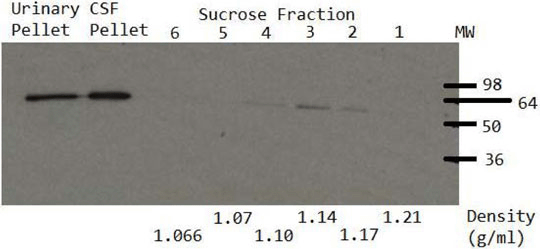Human cerebrospinal fluid contains exosomes that represent a novel reservoir for therapeutic biomarker discovery One of the pathological hallmarks of neurodegenerative diseases, such as spongiform encephalopathies (TSEs) and Alzheimer’s dementia (AD), is the accumulation of abnormal proteins within brain tissue (prions in TSEs and b-amyloid in AD). Studies in cell culture have demonstrated these proteins are released from cells within lipid vesicles termed exosomes [1]. In vitro, the exosomal protein content changes with drug therapy, which suggests that exosomes could represent a reservoir for therapeutic biomarker discovery. Our aim was to determine if exosomes are present in human cerebrospinal fluid (CSF). CSF was collected from patients undergoing thoraco-abdominal aortic aneurysm repair (with full ethical approval). This group was chosen as they have a CSF drain inserted peri-operatively as part of routine clinical management. The CSF was ultracentrifuged (as per established protocols for urinary exosome isolation [2]) and the presence of exosomes was tested by western blotting for specific markers, sucrose gradient centrifugation, immunoelectron microscopy and the proteome was explored by tandem mass spectrometry. The exosomal markers TSG101 and Flotillin-1 were found to be enriched in the ultracentrifugation pellet over the unfractionated CSF. Using sucrose gradient centrifugation, the density of the ‘microvesicles’ was established as 1.14 - 1.20 g.cm-3, consistent with the density previously reported for exosomes (see figure). Staining for Flotillin-1 during electron microscopy revealed the presence of Flotillin-1 on structures consistent in size and shape with previous reports for exosomes. Alpha-2-macroglobulin, which is involved in the clearance of A-beta, and filamin-A, which is linked to periventricular heterotopia, were identified in the exosomes by tandem mass spectrometry. Based on this evidence, we conclude that human CSF contains exosomes. The existence of exosomes provides a source for new diagnostic and therapeutic biomarkers and proteomic discovery studies are ongoing.

1. Faure J et al. Molecular and cellular neurosciences 2006; 31: 642-8. |
|

